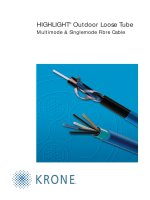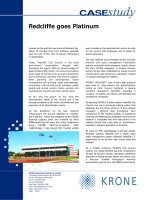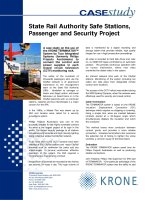Tài liệu TIA 606 & Cable Labeling techniques pdf
Bạn đang xem bản rút gọn của tài liệu. Xem và tải ngay bản đầy đủ của tài liệu tại đây (641.58 KB, 6 trang )
12
INSTALLATION
www.cablingbusiness.com
Cabling Business Magazine • May 2005
N
ew Technology.
Workplace
Expan-sion.
Repairs and
Upgrades. With every change in
the workplace comes a correspond-
ing need to find, move, repair, or add
cables to your system. Over time,
your telecommunications closets can
become an impenetrable jungle of
cables, and any work on your telecom
system becomes an exercise in trial
and error. Without proper documenta-
tion and labeling, any effort to work on
your telecommunications system or do
a physical audit can take hours or
even days.
Proper documentation and label-
ing of your network, using the ANSI/
TIA/EIA-606-A Administration Standard
for Telecommunications Infrastructure,
can save you time and money in
many ways:
• Faster, more efficient installation and
maintenance
• Easier physical audits
• Aids in troubleshooting
• Helps locate unused cable – saves
money on time and materials
• Avoids network downtime
Keeping your network up and run-
ning is vital to the profitability of compa-
nies that rely upon their telecom systems
to conduct business or complete trans-
USING THE CLASS SYSTEM
TO DOCUMENT AND LABEL
YOUR INSTALLATION
By James Pettit
actions.
W h i l e
many telecom-
m u n i c a t i o n s
installers may
balk at the time
they think is needed to
implement a 606-A compli-
ant solution, the right labels,
printing system and software can
make documentation and labeling a
nearly seamless part of the installation
process, saving countless hours in the
future.
By reducing network downtime,
a 606-A compliant documentation
and labeling solution can be easily
cost-justified.
A BRIEF OVERVIEW OF THE
606-A STANDARD
The 606-A standard is a simplified
version of the old 606 standard, and it
has been in use for a few years. The
new standard is clearer, easier to fol-
low, modular and scalable – so that you
can expand to higher classes
within the standard without changing
any existing identifiers or records. While
the 606-A standard is not a code (there
are no penalties for non-compliance),
it is a best practice that will help
your company maintain an efficient
telecom system that runs at peak
performance.
The standard specifies a uni-
form administration approach for
telecommunications cabling systems
that supports a multi-product, multi-
vendor environment. This means that
the labeling and documentation sys-
tems outlined in the standard are inde-
pendent of any specific applications,
which change as technology changes.
The 606-A standard works over the life
of your telecommunications system, no
matter what additions or changes may
be made to your technology over time.
In fact, with proper documentation and
labeling, these additions and changes
are made faster and easier through
consistent cable documentation and
labeling.
14
LETTER FROM THE EDITOR
www.cablingbusiness.com
Cabling Business Magazine • May 2005
The standard is not only for tele-
com installers. It establishes guide-
lines for company owners, end users,
manufacturers, consultants, contrac-
tors, designers, installers and facilities
administrators. By using one standard-
ized system, the documentation created
with the 606-A standard will be useful
to anyone who needs in-depth infor-
mation about their telecommunications
cabling system.
CLASSES OF ADMINISTRATION
The 606-A standard is scalable,
offering four levels of administration
guidelines depending upon the size and
scope of your cabling system:
Class 1 – for systems within a
single building with one
Te l e c o m m u n i c a t i o n s
Room (TR) that all workstation
cables for that system run to.
Class 2 – for systems within a single
building that are served by
multiple TRs.
Class 3 – for a system that spans
multiple buildings, called a
campus environment.
Class 4 – for systems that span multiple
campuses. This is also called
a multi-site system.
This structure allows for a clear
understanding of what must be labeled
and documented at each class level.
Through a consistent labeling standard,
it is possible to know the nature and
location of every cable for every work-
station for any compliant telecommuni-
cations infrastructure. This offers huge
advantages to installers, administrators
and maintenance technicians – a com-
pliant labeling system expedites instal-
lations and repairs and keeps end users
more productive.
IDENTIFIERS AND RECORDS FOR
THE 606-A STANDARD
Labeling and administration of your
telecommunications infrastructure is
INSTALLATION
606-A COMPLIANT SOLUTIONS FROM BRADY
PRINTERS
IDXPERT™ LABELING
SYSTEM
• Portable, flexible printing
system
• Drop, Lock, and Go Smart
Cartridge allows users to easily
switch label materials
• Edge-to-edge printing capabilities
• Uses continuous tape or pre-cut labels
to avoid waste
• Frequently-used label formats can be stored for easy
retrieval
TLS2200™ PRINTER
• Handheld and desktop
versions available
• Prints self-laminating, die-
cut, and continuous tape
labels
• PC compatible for fast
label formatting and data
downloads
• Ideal for medium-volume
label printing
ID PAL™ LABELING TOOL
• Entry-level, value priced tool
• Easy to use, ideal for on-site, on-demand
labeling
•
Prints continuous tape, six 606-A-compliant
colors available
• Prints Brady high-quality labels
that stick to wires, curved surfaces,
or powder-coated surfaces
• Recommended for low volume label
printing
clearly outlined in the 606-A standard for
each class, as follows:
Class 1 – This level calls for
the identification and record of the
Tenant Space (TS), all horizontal links
(where the cable is from and where
it goes), the Telecommunications
Main Grounding Busbar (TMGB) and
the Telecommunications Grounding
Busbar (TGB).
Practically speaking, Class 1 identi-
fiers and records focus on labeling and
documentation of cables from the work-
station to the Telecommunications Room
(TR), including all outlets and grounding
points. From a user’s or installer’s per-
spective, this allows for easy identifica-
tion of application cables for computers,
printers, phones, etc. Anyone who has
followed a cable from one end of the
office to the other, just to see which
cable needs to be moved or replaced,
can appreciate the advantage of a clear
labeling and documentation standard.
Horizontal links include identifiers
for cable (at both ends), faceplates/out-
lets and termination hardware (patch
panels, 110 blocks and 66 blocks).
Class 2 – These systems require
everything specified for Class 1, plus
identifiers and records for intra-building
backbone cable, pair, and/or strand,
and firestopping points.
Building on the Class 1 system,
these labels and records show con-
nections between TRs within a building,
grounding points throughout the build-
ing, and the locations where firestopping
material has been installed.
Documentation also must include
dates of firestopping installation, the
name of the installer, and the service
record for each firestopping location.
This helps maintain a fire-safe work envi-
ronment and can help make any build-
ing inspections faster and smoother.
Your system documentation should
also include detailed information about
the horizontal links, including the identi-
fier name, cable type, location of outlet/
connector, outlet connector type, cable
length, location of TS, cross-connect
hardware type, and service records for
the horizontal link. This complete record
of your system provides you with every-
thing an installer, inspector, administra-
tor or technician would need to know to
keep your system up and running.
In general, documentation must
include complete information regarding
the type of materials or hardware used
for cables, location of grounding points
and firestopping materials, the start and
end points for all cables, complete ser-
vice records, and access and contact
information. This helps your company
on a number of levels, including faster
maintenance and easier inspections and
audits. Beyond that, documentation will
show you if there are any gaps in safety
protocols within your telecom infrastruc-
ture, which can help your protect your
technology investment and ensure the
safety of your employees.
Class 3 – Campus environments
require all of the elements specified
in Class 1 and 2, plus identifiers and
records for interbuilding backbone
16
INSTALLATION
www.cablingbusiness.com
Cabling Business Magazine • May 2005
Circle Reader Card #111
cable, pair, and/or strand, and building
records.
A multi-building environment, as is
often seen in universities or hospitals, is
a complex system involving hundreds of
workstations, dozens of TRs, and miles
of cable. This is where a clear label-
ing format is vital, and documentation
essential, since multiple people will be
responsible for installation, upgrades,
and maintenance of the telecommunica-
tions infrastructure.
Class 4 – At this level, administra-
tion is required for each site, as well as
for all of the elements, already listed for
Class 1, 2 and 3.
WHY USE THE 606-A STANDARD?
Because the 606-A standard is not
a code, companies are not required to
follow the guidelines in their entirety.
But why follow them at all? Why not
develop your own labeling and docu-
mentation system?
The 606-A Standard has several
and consultants.
Up until recently, many compa-
nies had one person who knew their
system’s ins and outs and who was in
charge of all installations, upgrades, and
maintenance. This leaves the company
vulnerable if that person is off, leaves
for another position, or retires. Suddenly
you may find yourself with hundreds
of unlabeled, undocumented cables
and no idea what goes where. Or, you
may have an idiosyncratic system that
makes sense only to the individual who
designed it, making it useless for a new
a d v a n t a g e s ,
making it a best practice for all telecom-
munications infrastructure labeling and
documentation.
THE 606-A STANDARD:
• Is simple enough to be administered
and maintained;
• Offers a huge ROI in terms of mainte-
nance and upgrades;
• Is scalable for future expansions,
upgrades, or new building locations;
• Is intuitive to technicians, contractors,
17
www.cablingbusiness.com
Cabling Business Magazine • May 2005
INSTALLATION
Circle Reader Card #112
Circle Reader Card #113
person or an outside technician. This
leaves your company investing more
time to re-locate and re-label your tele-
com system. By using the 606-A stan-
dard, your labeling and documentation
can be done once and updated as your
system is updated.
WHAT ABOUT UNLABELED
EXISTING SYSTEMS?
For many companies, their tele-
com infrastructure started with a one
TR containing a few cables for a hand-
ful of phones and computers. As the
company added technology and work
stations, more cables were added and
outdated technology was disconnected,
all without the benefit of a standardized
documentation or labeling system. Now
these companies find that they’ve got
multiple TRs and a network of seem-
ingly random cables, several of which
may be entirely unused. Labeling and
documenting such a system can be a
daunting prospect.
If you’re starting or moving to a new
location, then of course that’s the ideal
time to start using a 606-A compliant
solution. But if not, you don’t have to
label all of your old cable at once. The
best time to begin using 606-A compli-
ant solutions is during new installations
or expansions, moves/adds/changes
(MACs) in your office, or while updating
technology or adding bandwidth. This
will show you the nature and location of
18
INSTALLATION
www.cablingbusiness.com
Cabling Business Magazine • May 2005
the newest cables, and you can label the
older infrastructure over time and/or as
you perform maintenance.
LABELING FORMATS IN THE
606-A STANDARD
The 606-A Standard calls for a
standard labeling format that indicates
the type, location and purpose of all
cables and endpoints, plus color coding
for faster and easier identification of all
elements.
These labels serve as the key to
finding additional information included
in the documentation.
Overall documentation includes
materials and maintenance information
for horizontal links as listed above, plus
additional access or personnel infor-
mation as needed for larger systems.
For example, the required record for
a Telecommunications Space (TS) as
specified in the 606-A standard would
include: the TS identifier name, type,
room number, key or access card iden-
tification, contact person, and hours of
access. This helps maintenance and
repair people do their jobs more effi-
ciently, and gets all users up and running
faster in the event of network problems.
LABEL AND DOCUMENTATION
REQUIREMENTS
A compliant 606-A administration
system may be managed through a
paper-based system, through general-
purpose spreadsheet software, or with
a special-purpose cable management
system. Each has its advantages in
terms of cost, availability and ease of
use. While a paper-based or spread-
sheet system may cost less to imple-
ment in the short term, a special-purpose
cable management system is faster and
more complete in the long-term, saving
time in the creation of both labels and
documentation. This savings of time can
translate to dollar savings very quickly
for a medium-to-large telecommunica-
tions system, or for one that upgrades
technology frequently.
All labels used in cable marking
should meet the following criteria:
• Labels must be of a size, color and
contrast to be easily visible and
readable
• Label materials must be resistant
to your location’s environ-mental
conditions (moisture, heat, UV light);
• All labels used must have a useful
life equal to or greater than the
component being labeled (this means
both adhesion and readability);
• Printing of labels must be done by a
mechanical device and not written by
hand (Anyone who’s tried to read a
handwritten label a year later, when
the ink is smudged, can get behind
this requirement.)
Many people, hoping to save money
on labels, will purchase standard office
labels from their office supply vendor
and print them on a standard printer.
They are then surprised to see all of their
labels littering the floor of the telecomm
closet a few months later.
Non-industrial label solutions are
not designed to stick on wires, curved
surfaces, or powder-coated surfaces.
The result is that the labels that work just
fine on file folders simply don’t stick on
wires, faceplates and other components
that are part your telecommunications
system. If the labels don’t stick, all









